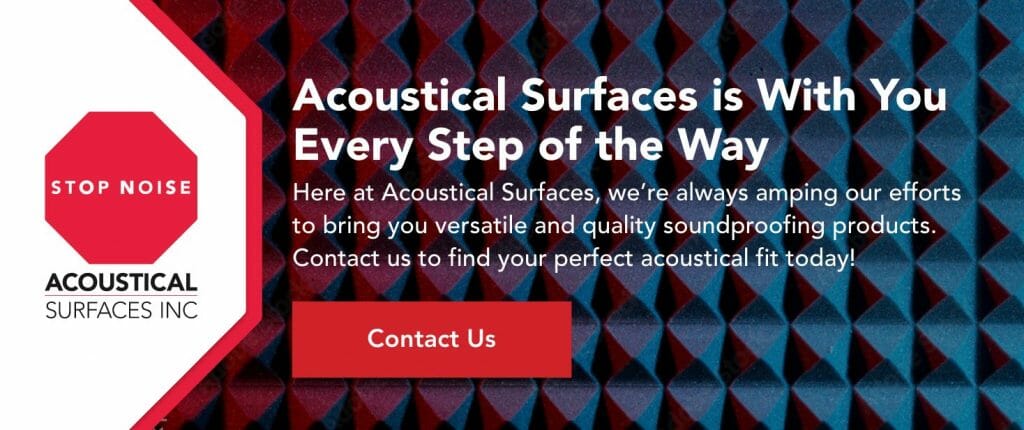Is Rubber Soundproof? Everything You Need to Know
Soundproofing—it’s a word used often, but what does it really entail?
At its core, soundproofing refers to the intricate process of barring sound from sneaking in or out of a given space. This is most commonly achieved by strategically deploying dense, airtight materials within walls, ceilings, floors, and even the tiniest crevices. The primary aim is to reflect the sound, ensuring it doesn’t slip through to the other side.
Now, when the time comes to design a soundproofed room, there are several materials to choose from. But what is the best soundproofing material? From acoustic foam to sound-deadening paints (AKA soundproofing paint), the list is extensive. But one contender stands out: rubber.
Is rubber really up to the best soundproofing material challenge?
Here’s what you need to know.
Is Rubber Soundproof?
If you’re designing a space with a focus on acoustics, you’re bound to encounter two terms: “soundproofing” and “sound absorbing.” Those new to acoustic panel design might mix these up or use them as synonyms. However, they serve distinct and complementary roles in shaping a space’s sound dynamics.
Soundproofing employs dense, airtight materials, like rubber, within walls, ceilings, and floors. Its primary function is to block external noise, reflecting sound waves.
In contrast, sound absorbing seeks to enhance a room’s internal sound quality. Soft, porous materials—such as wood wool or foam acoustic panels—are deliberately placed on surfaces to soak up sound vibrations, reducing echoes and reverberations.
The inherent properties of rubber—its density and elasticity—make it an ideal barrier for soundproofing, effectively blocking unwanted noise. However, these same characteristics don’t lend themselves to sound absorption, which requires materials that can trap and dissipate sound energy.
Types of Rubber Soundproofing
So, is rubber good for soundproofing? The answer is a resounding yes.
Rubber has long been recognized for its potential as a soundproofing solution. Its basic use involves laying down a thin layer of rubber mats or tiles to dampen vibrations and prevent the unwanted transmission of noise from one side of a sound barrier to another.
However, as the technology has evolved, so too have the applications of rubber in acoustic design. Enter specialty rubber acoustic solutions like ACOUSTIK Sound Deadening Floor Underlay.
Made of high-performance recycled rubber, this specialized soundproofing material is installed beneath the floor to provide superior noise control. Not only does it effectively reduce the transmission of sound between levels, but it also dampens vibrations that can cause noise disturbances. And the benefits don’t stop at soundproofing. ACOUSTIK is:
- Easy to install
- Cost-effective
- Eco-friendly
- Durable
- Provides STC & IIC ratings
- May contribute toward LEED(R) credits
- Comfortable and resilient
- Sold by the roll
Practical Applications of Rubber for Soundproofing
Among the myriad soundproofing solutions, rubber stands out not just for its effectiveness but also its cost-efficiency. Its unique properties—combined with affordability—make it a sought-after material across a variety of industries.
Here are a few of the more common practical applications for rubber as a soundproof material:
- Homes and buildings – Rubber is a popular choice in both residential and commercial projects. In homes, it’s often found as underlayment beneath floors or integrated into walls to mute footfalls and ambient or airborne noise. Commercial spaces, especially those needing privacy like conference rooms or theaters, utilize rubber acoustic panel or tiles for enhanced sound insulation.
- In the automotive industry – Cars, trucks, and other vehicles benefit immensely from rubber soundproofing. It’s commonly used in acoustic panels, acoustic doors, under the carpeting, and within the engine compartments to reduce road noise, vibration, and the hum of the engine, ensuring a quieter ride.
- Specialty uses – Beyond everyday usage, rubber plays a pivotal role in niche applications. For instance, in recording studios, rubber is employed not just for soundproofing but also for creating the right acoustics. Similarly, in machinery rooms or industrial sites, rubber barriers can help mitigate harsh mechanical noises, protecting workers’ hearing and reducing noise pollution.
Other Popular Soundproofing Materials
Soundproofing has evolved dramatically over the years. Gone are the days when limited choices meant compromising on the quality of sound insulation. Now, thanks to technological advancements and deeper acoustical understanding, the options for soundproofing have grown substantially, allowing for more effective and varied solutions.
Besides rubber, common soundproofing materials include:
- Green Glue vibration dampening compound – Think of this as a buffer for your walls. Sandwich it between two layers of sheetrock and it will dampen the vibration energy that would otherwise travel freely between the drywall.
- RSIC-1 Clips (resilient sound isolation clips) – These are hardware components comprising a metal bracket and rubber isolator designed to decouple walls and ceilings from their structure, significantly reducing sound transmission by allowing drywall to “float” and thereby breaking the path of the sound vibration.
- Mass loaded vinyl barrier (MLVB) – Crafted from high-density limp mass barrier material, this sound barrier is specifically designed to thwart noise transmission.
- Soundbreak XP soundproof sheetrock – An upgrade on standard drywall. This material is primarily used in constructing walls with high STC (Sound Transmission Class) ratings, it’s a sound-deadening marvel, contributing majorly to creating quieter, more serene spaces.
Effectively Soundproof Your Space with Acoustical Surfaces
In the vast and evolving landscape of soundproofing, rubber emerges as a versatile, effective, low-cost solution. But, creating an acoustically sound room goes beyond selecting the right rubber materials—they must be applied and installed precisely.
That’s where the experts at Acoustical Surfaces can make the difference. Our team can collaborate with you to understand your space, sound needs, and specific challenges, ensuring that the rubber soundproofing solutions are tailored to perfection.
Ready to soundproof your space? From acoustic panels to soundproof interior door, we have noise-control products that will both beautify your home and make it more peaceful. Contact our team today.




